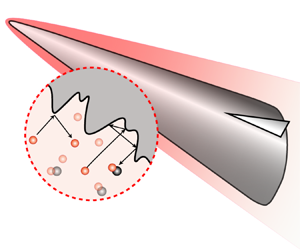Article contents
Theoretical modelling of non-equilibrium reaction–diffusion of rarefied gas on a wall with microscale roughness
Published online by Cambridge University Press: 20 June 2023
Abstract

Heat and mass transports through a rough surface are among the most fundamental and important phenomena in either natural or engineering problems. In this paper, theoretical modelling and direct simulation Monte Carlo method are employed to study the heterogeneous reaction–diffusion features induced by microscale roughness which is comparable to the molecular mean free path of the ambient gas. A quasi-one-dimensional homogeneous model is proposed, and it consists of an external diffusion region outside the roughness elements and an internal reaction–diffusion region which could be equivalent to a smooth surface with an effective chemical property. The external macroscopic diffusion can be characterized by a non-equilibrium criterion – the Damköhler number. The internal diffusion in micro-cavities must be analysed by considering the rarefied gas effects on the diffusivity, and another non-equilibrium criterion, the Thiele number, is introduced to evaluate the effective boundary condition imposed on the external region. Analytical formulae based on these criteria are derived to predict the equivalent surface reaction–diffusion performance, and the predictions compare well with the numerical results of different types of surface reaction, even on the three-dimensional roughness. This reveals that the roughness could either enhance or weaken the apparent reaction rate depending on the non-equilibrium degree. This study could enrich our understanding of the gas–surface interactions on a rough wall, such as the oxidation, catalysis and energy accommodation, and also preliminarily provides a practical method for evaluation of the aerothermochemical performance of coating materials of hypersonic vehicles.
- Type
- JFM Papers
- Information
- Copyright
- © The Author(s), 2023. Published by Cambridge University Press
References
- 1
- Cited by





